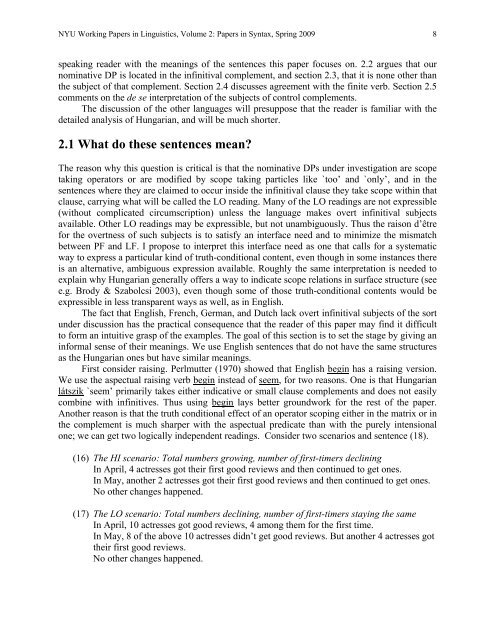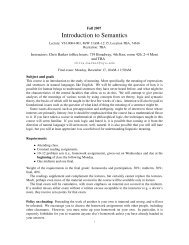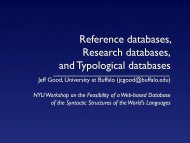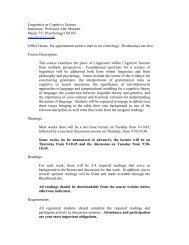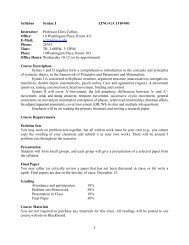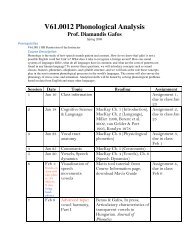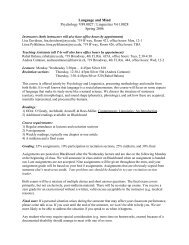Overt Nominative Subjects in Infinitival Complements Cross - NYU ...
Overt Nominative Subjects in Infinitival Complements Cross - NYU ...
Overt Nominative Subjects in Infinitival Complements Cross - NYU ...
You also want an ePaper? Increase the reach of your titles
YUMPU automatically turns print PDFs into web optimized ePapers that Google loves.
<strong>NYU</strong> Work<strong>in</strong>g Papers <strong>in</strong> L<strong>in</strong>guistics, Volume 2: Papers <strong>in</strong> Syntax, Spr<strong>in</strong>g 2009 8speak<strong>in</strong>g reader with the mean<strong>in</strong>gs of the sentences this paper focuses on. 2.2 argues that ournom<strong>in</strong>ative DP is located <strong>in</strong> the <strong>in</strong>f<strong>in</strong>itival complement, and section 2.3, that it is none other thanthe subject of that complement. Section 2.4 discusses agreement with the f<strong>in</strong>ite verb. Section 2.5comments on the de se <strong>in</strong>terpretation of the subjects of control complements.The discussion of the other languages will presuppose that the reader is familiar with thedetailed analysis of Hungarian, and will be much shorter.2.1 What do these sentences mean?The reason why this question is critical is that the nom<strong>in</strong>ative DPs under <strong>in</strong>vestigation are scopetak<strong>in</strong>g operators or are modified by scope tak<strong>in</strong>g particles like `too’ and `only’, and <strong>in</strong> thesentences where they are claimed to occur <strong>in</strong>side the <strong>in</strong>f<strong>in</strong>itival clause they take scope with<strong>in</strong> thatclause, carry<strong>in</strong>g what will be called the LO read<strong>in</strong>g. Many of the LO read<strong>in</strong>gs are not expressible(without complicated circumscription) unless the language makes overt <strong>in</strong>f<strong>in</strong>itival subjectsavailable. Other LO read<strong>in</strong>gs may be expressible, but not unambiguously. Thus the raison d’êtrefor the overtness of such subjects is to satisfy an <strong>in</strong>terface need and to m<strong>in</strong>imize the mismatchbetween PF and LF. I propose to <strong>in</strong>terpret this <strong>in</strong>terface need as one that calls for a systematicway to express a particular k<strong>in</strong>d of truth-conditional content, even though <strong>in</strong> some <strong>in</strong>stances thereis an alternative, ambiguous expression available. Roughly the same <strong>in</strong>terpretation is needed toexpla<strong>in</strong> why Hungarian generally offers a way to <strong>in</strong>dicate scope relations <strong>in</strong> surface structure (seee.g. Brody & Szabolcsi 2003), even though some of those truth-conditional contents would beexpressible <strong>in</strong> less transparent ways as well, as <strong>in</strong> English.The fact that English, French, German, and Dutch lack overt <strong>in</strong>f<strong>in</strong>itival subjects of the sortunder discussion has the practical consequence that the reader of this paper may f<strong>in</strong>d it difficultto form an <strong>in</strong>tuitive grasp of the examples. The goal of this section is to set the stage by giv<strong>in</strong>g an<strong>in</strong>formal sense of their mean<strong>in</strong>gs. We use English sentences that do not have the same structuresas the Hungarian ones but have similar mean<strong>in</strong>gs.First consider rais<strong>in</strong>g. Perlmutter (1970) showed that English beg<strong>in</strong> has a rais<strong>in</strong>g version.We use the aspectual rais<strong>in</strong>g verb beg<strong>in</strong> <strong>in</strong>stead of seem, for two reasons. One is that Hungarianlátszik `seem’ primarily takes either <strong>in</strong>dicative or small clause complements and does not easilycomb<strong>in</strong>e with <strong>in</strong>f<strong>in</strong>itives. Thus us<strong>in</strong>g beg<strong>in</strong> lays better groundwork for the rest of the paper.Another reason is that the truth conditional effect of an operator scop<strong>in</strong>g either <strong>in</strong> the matrix or <strong>in</strong>the complement is much sharper with the aspectual predicate than with the purely <strong>in</strong>tensionalone; we can get two logically <strong>in</strong>dependent read<strong>in</strong>gs. Consider two scenarios and sentence (18).(16) The HI scenario: Total numbers grow<strong>in</strong>g, number of first-timers decl<strong>in</strong><strong>in</strong>gIn April, 4 actresses got their first good reviews and then cont<strong>in</strong>ued to get ones.In May, another 2 actresses got their first good reviews and then cont<strong>in</strong>ued to get ones.No other changes happened.(17) The LO scenario: Total numbers decl<strong>in</strong><strong>in</strong>g, number of first-timers stay<strong>in</strong>g the sameIn April, 10 actresses got good reviews, 4 among them for the first time.In May, 8 of the above 10 actresses didn’t get good reviews. But another 4 actresses gottheir first good reviews.No other changes happened.


